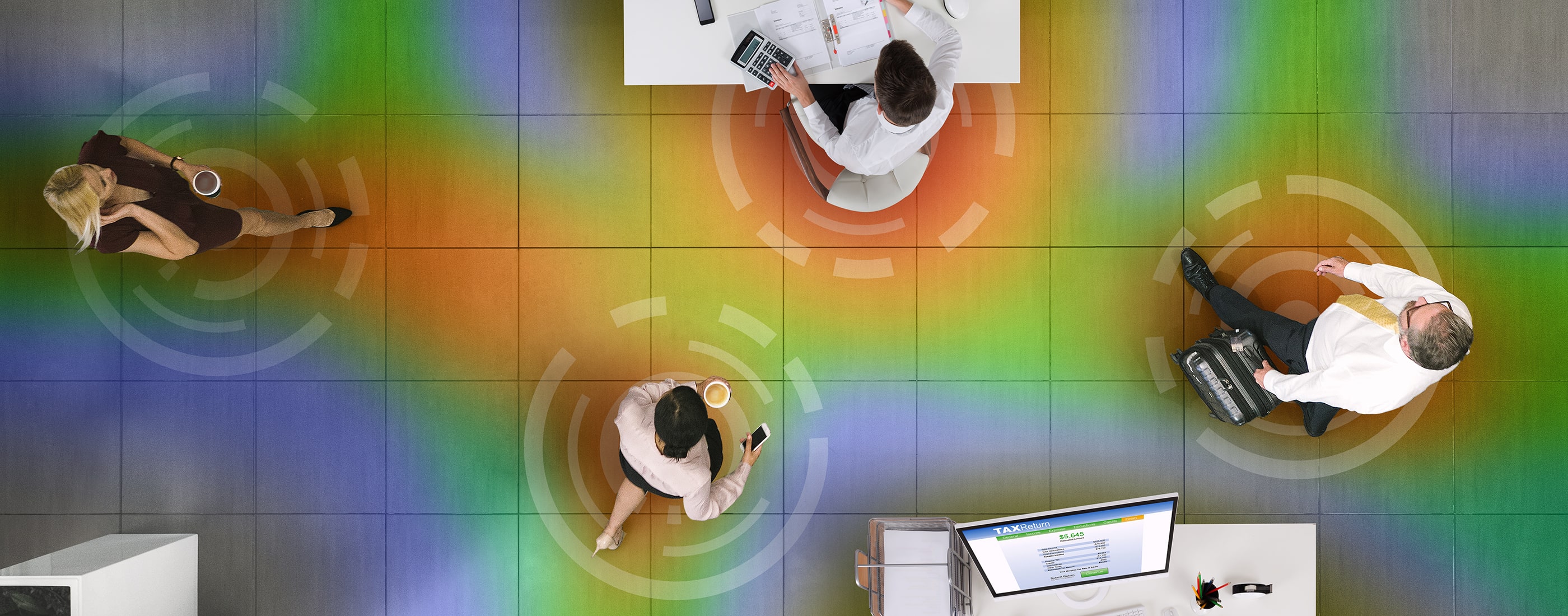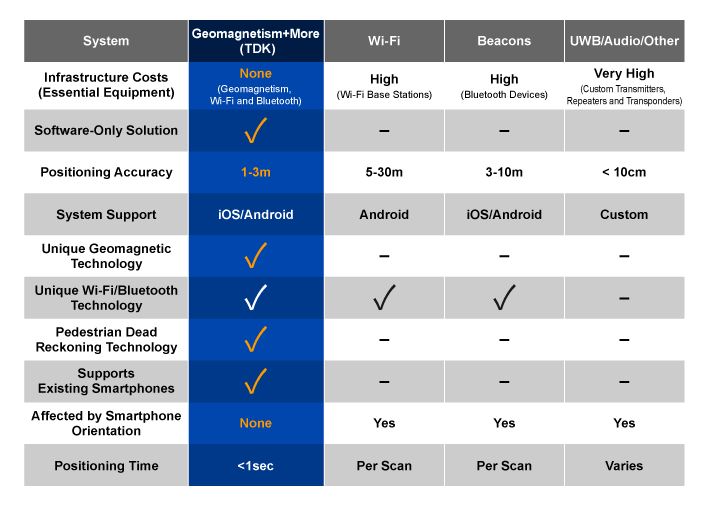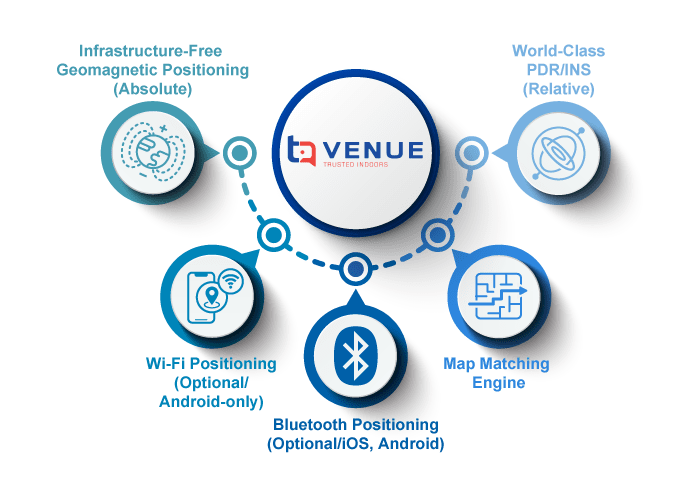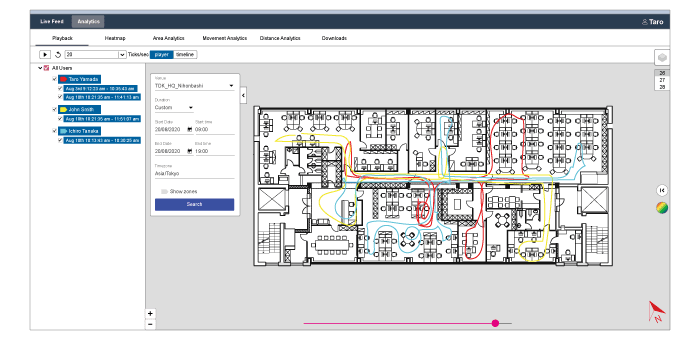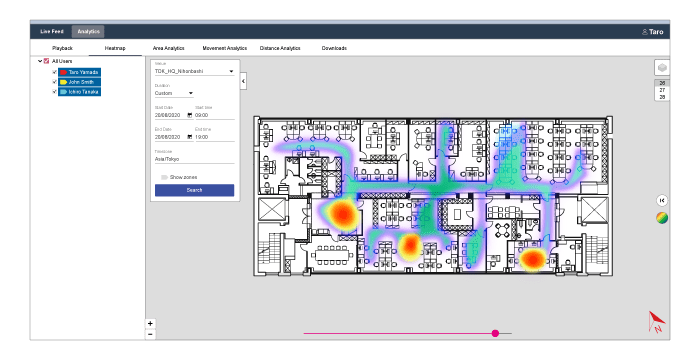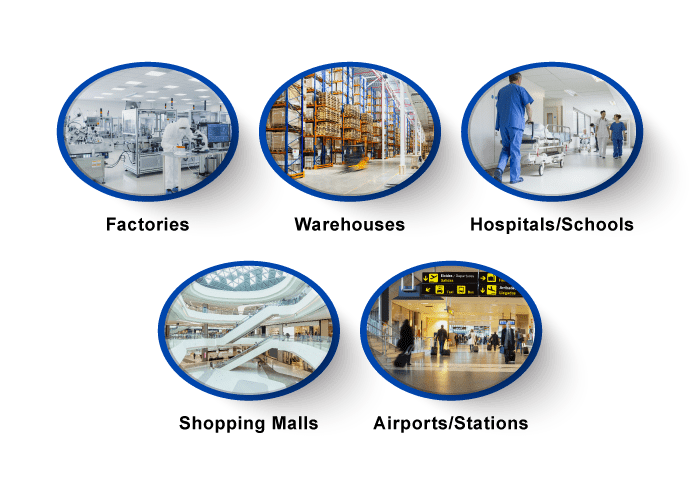Could an Indoor Location Information System Become a Magic Bullet that Mitigates COVID-19?
The Need to Monitor Workers at Offices and Factories
Keeping a safe distance from others and avoiding contact is essential to prevent getting infected with COVID-19. However, there are many situations in which avoiding contact with others is difficult at indoor locations such as offices and factories. Hence, there is a growing need for technologies that ensure workers’ health and safety and prevent the spread of infection by monitoring contact between workers and recording their movements in real-time.
For outdoors, Global Navigation Satellite Systems (GNSS) and Bluetooth Low Energy (BLE) ranging work effectively for determining the positions of people and objects relative to one another. Meanwhile, for indoors, location information can be obtained using various wireless communication technologies including Wi-Fi, Bluetooth, and Ultra-wideband (UWB)*1. For example, Bluetooth beacons*2 have been deployed at commercial facilities to enable services that provide location-relevant information to customers with smartphones. The positioning accuracy of Bluetooth, however, is only around three to ten meters and is dependent on infrastructure installation. To be useful for contract tracing of infectious diseases, the number of beacons must be increased to achieve an adequate level of accuracy. UWB technology features high positioning accuracy, but deployment in a wide area would require installation of a large number of radio transceivers and repeaters, putting it at a cost disadvantage.
Introducing a Location Information Solution Based on Geomagnetism
Given this background, a solution using geomagnetism*3 is attracting attention as a means to obtain indoor location information. TDK has developed VENUE, a location information solution that displays the real-time locations of people by utilizing geomagnetic sensors found in today’s smartphones. Each indoor location has a geomagnetic signature that can be used to ascertain the position of the phone.
There are several approaches to indoor positioning, but geomagnetism, tightly coupled with inertial navigation*4, optimally balances accuracy, reliability, and cost of deployment and maintenance.
“The beauty of geomagnetic positioning is that it works in all large venues whose structures interfere with Earth’s magnetic field, making this an infrastructure-free approach to indoor positioning that is accurate to better than 2 meters,” said Chris Goodall, Founder and current Managing Director of Trusted Positioning Inc., a TDK Group Company.
VENUE requires only the creation of geomagnetic maps that combine an indoor layout map with the geomagnetic data of that particular location acquired through a survey, with no need to install new devices and terminals. This leads to low installation cost, a major strength of VENUE. The accuracy of positioning using geomagnetism is approximately two meters—sufficient for tracing contact with infected persons, especially when combined with indoor layout maps. In addition, VENUE provides a position display with even higher accuracy by combining geomagnetic information with information from accelerometers*5 and gyroscopic sensors*6 inside smartphones.
“People may hold their smartphones while walking or put them in their pockets or bags. Since the orientation to the user changes constantly, the movements and pedestrian use-cases need to be corrected using inertial sensors. Solving these issues was the greatest challenge for practical applications such as tracking, and took our team many years to create, protect, and perfect,” according to Goodall.
Real-World Trial of a Contact Tracing App Already Under Way
Beginning in August 2020, a contact tracing trial among workers is being conducted at TDK’s headquarters in Nihonbashi, Tokyo, using VENUE. Employees carry smartphones with a special app installed, and their locations and movement histories on the floor are combined with anonymous identification information. The positions of a person are analyzed in combination with the indoor structure to better identify primary contacts and remove false contacts through walls or other barriers. If an employee is found to be infected, the data will be analyzed to identify people who had primary contact with that employee within the preceding two weeks, and measures such as a stay-at-home instruction will be taken. The contact tracing process is automated and optimized for complex indoor spaces.
This solution can not only identify those who were in close contact with the infected person as primary contacts, but also trace those who stayed in areas where the infected person had been shortly before as potential ‘area contacts.’ Analysis that combines location and elapsed time enables more effective contact tracing by improving primary contact tracing indoors and enabling area-based contact tracing over time.
*These are conceptual illustrations of screens that are currently under development.
Indoor Location Information Services Opens New Possibilities
Because VENUE can display the positions and histories of people and objects using not only workers’ smartphones but special tags containing geomagnetic and inertial sensors (under development), it can be deployed for a wide range of applications beyond contact-tracing of infectious diseases, such as monitoring the flow of employees to improve operational efficiency, or tracking the positions of equipment to manage their operational statuses. TDK is currently working with a number of companies to propose a variety of solutions to improve business efficiencies using location information.
“When we introduced open seating to all floors of our offices, we decided to maintain a ‘real-time seating chart’ using VENUE. Since we can all see where everybody is, we hope this will invigorate communication across departments.” (Hiroyuki Konuma, President, Sato Corporation)
“Until now, we have been using BLE beacons to manage the movement of workers, materials, and equipment in warehouses, factories, and construction sites. Deployment and maintenance was costly, but we believe using VENUE will be highly effective in reducing costs, especially in large-scale facilities.” (Toshihiko Tamura, General Manager of the Corporate Planning Division at ZENRIN DataCom)
VENUE is also useful for other modes of contact tracing, such as human to machine, human to vehicle, and human to robot. As the future work environment is expected to change dramatically with automation, in order to prevent man-machine interaction from posing new safety risks, VENUE hopes to improve safety with all types of contact tracing applications.
VENUE is an indoor location information solution that enables highly accurate location information to be obtained while keeping infrastructure costs down. Similar to the expansion of GPS for outdoor positioning applications in the past, the presence of indoor positioning technologies will likely grow in our everyday lives.
For more information about VENUE, please visit the website.
Terminology
- Ultra-wideband: A form of wireless communication that utilizes an extremely wide bandwidth of more than 20% or more than 500 MHz.
- Beacon: A technology for acquiring location information based on Bluetooth Low Energy (BLE), a short-range wireless technology featuring low power consumption. Also, a device that uses this technology.
- Geomagnetism: The magnetism and magnetic field generated by the earth. Because it is unique to every location on Earth, it can be used to identify location information both indoors and outdoors.
- Inertial navigation: A system that accurately determines its own position by calculating speeds and distances using accelerometers gyroscopic sensors. Used in navigation systems for automobiles and aircraft.
- Accelerometer: A sensor that detects the acceleration of an object. It can measure the movement and tilt of an object, and is equipped on many smartphones.
- Gyroscopic sensor: Also known as angular velocity sensors, gyroscopic sensors can detect changes in device orientation and motion, and are used in applications such as image stabilization in digital cameras and car navigation systems.
